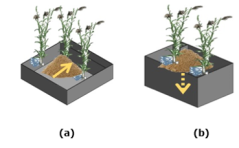
News
Science: Nature’s cleaningpower. Using constructed wetlands to purify industrial wastewater
As part of Water Nexus, a NWO-TTW program that aims to find solutions for fresh water shortage, PhD researcher Thomas Wagner investigates the use of constructed wetlands to remove chemicals from industrial wastewater. Wagner: ‘By creating such a nature-based water-cleaning system, industry and nature could go hand in hand, while recycling precious fresh water resources.’
‘Look at the difference in color between the ingoing and the outgoing water’, Thomas Wagner says. He holds two Erlenmeyers, containing water samples before and after they passed through his constructed wetlands. One Erlenmeyer holds a brownish fluid, while the liquid in the other one is clear. ‘The bottom sediments filter the brown humic acids out, while microorganisms together with the plants and the sediment, also remove chemicals like the corrosion inhibitor benzotriazole as well as nitrate and phosphate.
Wagner studies how constructed wetlands may remove chemicals from industrial waste water. He specifically focuses on cleaning water from industrial cooling towers. ‘Many industries use fresh water for cooling purposes’, he explains. The salinity of that water increases during the cooling process as result of evaporation and the water has to be discharged when the salinity becomes too high. Reusing this discharged water in the cooling tower itself would lower the fresh water footprint of the cooling tower, but requires desalination. ‘However, to prevent
corrosion, excessive bacterial growth and deposition of calcium salts (scaling) in the cooling system, they add corrosion inhibitors, but also biocides, like glutaraldehyde and phosphonates as anti-scalants.’ Desalinating this cooling water for reuse therefore requires a pre-treatment, where these chemicals are removed first. Constructed wetlands may play a key role here.
Different designs
Wagner focuses on different removal mechanisms of chemicals present in his lab-made industrial water mix, mimicking the real industrial cooling water. It contains a mixture of different salts, nitrate, phosphate and the corrosion inhibitor benzotriazole. Removal of chemicals may be due to adsorption to the sediment, microbiological breakdown in the sediment, or uptake and degradation by the plants. In addition, he looks at different constructed wetland designs (Fig. 1a,b) to find out the most optimal system for cleaning his water mix. ‘We study both horizontal and vertical water flows through the sediments’, he explains. ‘With the vertical flow design, water moves from the surface through the sediment and absorbs more oxygen than with the horizontal flow design.’

Fig. 1. Wetland design with a horizontal (a) and vertical (b) water-flow through the sediment.
This difference in oxygen content also influences the activity of different bacteria and consequently the breakdown of different chemicals. For example, adsorption to the sediment is the most important removal mechanism for benzotriazole. But due to the oxygen present in a vertical flow system, aerobic bacteria add to the removal of this compound, resulting in an overall better performance to remove benzotriazole. In contrast, nitrate is more efficiently removed in the more anaerobic horizontal system, where anaerobic bacteria are active. Another important factor for efficient chemical removal is the temperature. Wagner:‘Lower temperatures may result in lower removal rates as result of lower microbial activity. In addition, when plants die in late-autumn, they do not take up contaminants and don’t provide oxygen to the constructed wetland anymore.
Complicating factor
In addition to oxygen present and the ambient temperature, also biocides present in cooling water, like glutaraldehyde, a compound resembling formaldehyde, may impact the cleaning effectivity of the constructed wetland. An extra complicating factor here is the partial breakdown of such biocides, resulting in the formation of completely new compounds with different toxic properties. This might have implications for the proper cleaning function of the system. Therefore, Wagner also focuses on the impact of these biocides on chemical removal rates. ‘In theory, these toxic compounds may slow down biodegradation, but our experiments showed that the lowest concentrations used in cooling towers, 5 micrograms per liter, didn’t reveal any effects’, Wagner says. ‘If we find an impact at higher concentrations, we may have to include an extra biocide removal step or find a biocide with less impact on our constructed wetlands.’
Natural look
Despite some challenges, Wagner is convinced that constructed wetlands can play an important role in thepre-treatment of industrial cooling water, before the final desalination step. Depending on the compounds to be removed, it is possible to make a custom wetland design, favoring the breakdown of specific compounds. For example, phosphate could be
more efficiently removed by mixing the sediment with better absorbing substances. Aluminum sludge, rest materials from the drinking water industry, is a potentially good candidate. But also, the bacterial populations, responsiblefor the breakdown of different compounds can be manipulated: aerobic bacteria can be favored by aeration of the system using air pumps. This may result in a better breakdown of, for example, benzotriazole. In addition to their effective removal of a wide variety of contaminants, constructed wetlands are appealing. Wagner: ‘By using them as natural waste water cleaners, nature and industry can go hand in hand.'
Selected publication
Wagner, T.V., Parsons, J.R., Rijnaarts, H.H.M., de Voogt, P., Langenhoff, A.A.M. 2018. A review on the removal of condi-tioning chemicals from cooling tower water in constructed wetlands. Crit. Rev. in Environ. Sci.& Technol.48, 1094-1125